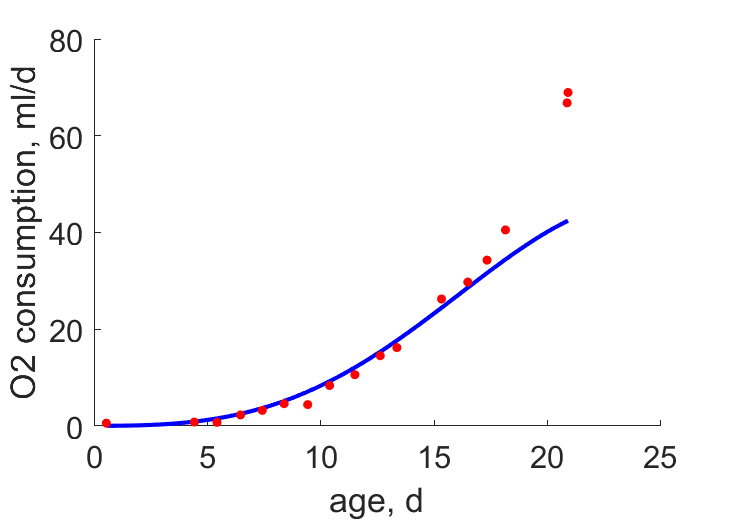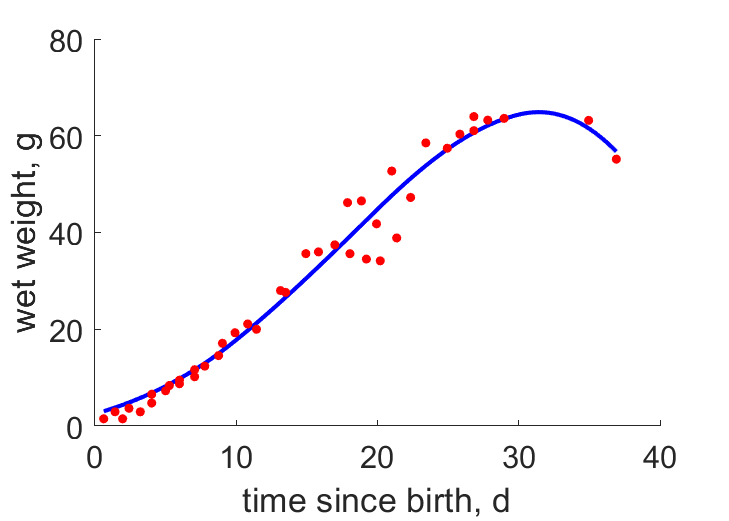Predictions & Data for this entry
| Model: std | climate: Af | migrate: | phylum: |
| COMPLETE = 2.8 | ecozone: TN | food: biHs | class: |
| MRE = 0.046 | habitat: 0iTf | gender: Dg | order: |
| SMSE = 0.006 | embryo: Tnwf | reprod: O | family: |
Zero-variate data
| Data | Observed | Predicted | (RE) | Unit | Description | Reference |
|---|---|---|---|---|---|---|
| ab | 21.5 | 19.01 | (0.1157) | d | age at birth | avibase |
| tx | 32 | 32.03 | (0.00106) | d | time since birth at fledging | Buch1983 |
| tp | 96 | 91.26 | (0.04943) | d | time since birth at puberty | guess |
| tR | 365 | 365 | ( 0) | d | time since birth at 1st brood | guess |
| am | 5548 | 5525 | (0.004161) | d | life span | guess |
| Ww0 | 3.93 | 3.231 | (0.1779) | g | initial wet weight | Buch1983 |
| Wwb | 2.32 | 2.444 | (0.05332) | g | wet weight at birth | avibase |
| Wwi | 55.7 | 57.11 | (0.02538) | g | ultimate wet weight | avibase |
| Ri | 0.01096 | 0.01073 | (0.02087) | #/d | maximum reprod rate | avibase |
Uni- and bivariate data
| Data | Figure | Independent variable | Dependent variable | (RE) | Reference |
|---|---|---|---|---|---|
| tJOe |  | age | O2 consumption | (0.07426) | Buch1983 |
| tW |  | time since birth | wet weight | (0.08411) | Buch1983 |
Pseudo-data at Tref = 20°C
| Data | Generalised animal | Bolborhynchus lineola | Unit | Description |
|---|---|---|---|---|
| v | 0.02 | 0.02477 | cm/d | energy conductance |
| p_M | 18 | 498.4 | J/d.cm^3 | vol-spec som maint |
| k_J | 0.002 | 0.02114 | 1/d | maturity maint rate coefficient |
| k | 0.3 | 0.3102 | - | maintenance ratio |
| kap | 0.8 | 0.9536 | - | allocation fraction to soma |
| kap_G | 0.8 | 0.8011 | - | growth efficiency |
| kap_R | 0.95 | 0.95 | - | reproduction efficiency |
Discussion
- Body temperatures are guessed
- scaled functional response turned out to vary
- mod_1: Pseudo-data point k is used, rather than k_J; Data set tp and parameter t_R are added, the latter replacing clutch interval t_N. Postnatal T is based on PrinPres1991, see get_T_Aves. See further the revision page, theme puberty
Bibliography